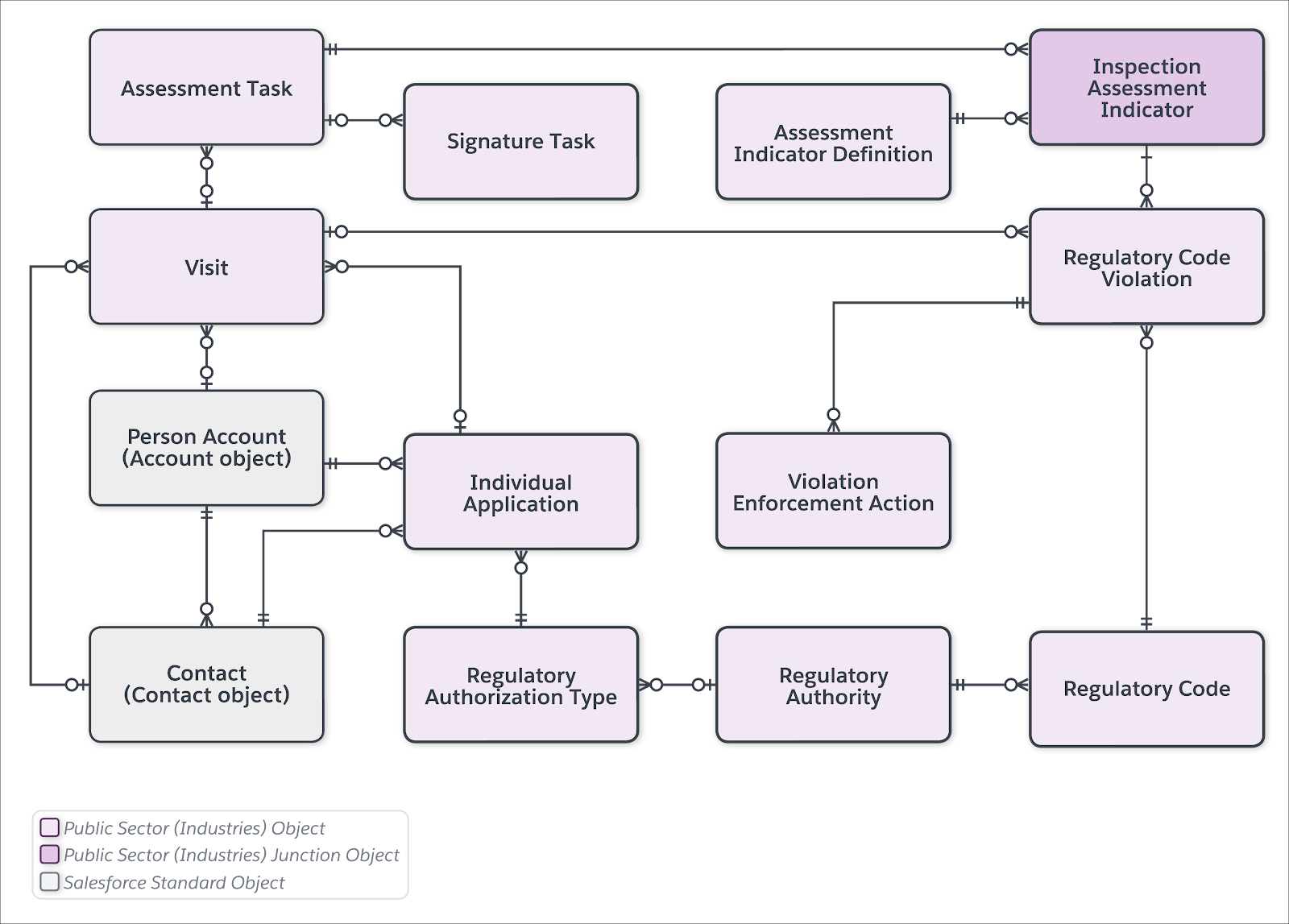See the Licensing, Permitting, and Inspections Data Model in Action
Learning Objectives
After completing this unit, you’ll be able to:
- Describe how licensing, permitting, and inspections objects work together in a business license application process.
- Describe how licensing, permitting, and inspections objects work together in an individual license application process.
Follow a Business License Application on the Approval Journey
The application process for a business license involves multiple steps and roles.
Business License Application: In Cosville, business is booming at Sunshine Salon (Business Account). So great, in fact, that owner Susan Adams (Contact) wants to open a second location. She rents a space, outfits it with all the equipment she needs—including chairs, mirrors, sinks, and hair dryers—and completes the online application on the Cosville public portal.
Regulatory Authority: An intake officer in the Cosville Tax Department reviews the application. The paperwork looks fine, but business licenses for salons in Cosville require an inspection, so the intake officer sends the application to the Board of Barbering and Cosmetology. At the board, compliance officer Salima Sheikh assigns inspector Amelia Zhu to make a health and safety check (Inspection Type) before Salima can approve the license.
Visit, Regulatory Code, and Assessment Task: Amelia visits the salon and, using the Public Sector Services Inspection Management app on her mobile device, begins to evaluate the site for compliance with the Board of Barbering and Cosmetology Codes and Procedures. Walking around the salon, Amelia performs a series of tasks. She checks for the presence of hazardous chemicals in the restroom.
Inspection Assessment Indicator and Signature Task: She answers a series of questions, such as “Does the establishment pass the hazardous chemicals check?”. Anytime Amelia needs a refresher, she can check the actual codes and procedures because they’re stored in her Inspection Management app! Amelia signs off as she completes the final task that captures her signature.
Regulatory Code Violation, Violation Enforcement Action: Happily, Amelia finds that Sunshine Salon is sparkling clean, hazardous chemicals are properly stored, no prohibited products are present, and signage is displayed correctly. Sunshine Salon is up to code! Amelia tells Susan that she finds no violations, so Susan doesn’t face any fines. Susan is thrilled when Amelia tells her that she'll recommend Salima to approve the Sunshine Salon business license application.

And here's a detailed look at the records, objects, and relationships in the Sunshine Salon business license application.
This Record… |
Is Related To |
|---|---|
Sunshine Salon (Business Account) |
|
Sunshine Salon License Application (Business License Application) |
|
Board of Barbering and Cosmetology (Regulatory Authority) |
|
Chapter 16, Section 114.8.B Prevention of Harmful Chemical Use (Regulatory Code) |
|
Sunshine Salon Inspection (Visit) |
|
Prohibited Products and Practices (Assessment Task) |
|
Inspection Checklist (Assessment Indicator Definition) |
|
Storing chemical supplies in the restroom (Regulatory Code Violation) |
|
Follow an Individual License Application on the Approval Journey
Similarly, an individual application for a license – to remodel a home, for example, involves multiple steps and roles.
Contact and Individual Application: Cosville resident Laura O’Brien recently got a promotion. She finally has money to do what she’s been wanting to do since she bought her house 10 years ago: Expand and remodel her kitchen. She has blueprints from an architect and a contractor ready to start work. All she needs is a home remodeling permit, so she submits an application to the Planning Department using the Cosville public portal.
Regulatory Authority and Inspection Type: A planner reviews Laura's application and then sends it to the Board of Building Safety and Construction so they can conduct a safety and code compliance check of Laura’s remodeling project.
Visit and Regulatory Code: Inspector Amelia Zhu goes to Laura’s house. Using the Public Sector Services Inspection Management app on her mobile device, she begins to evaluate Laura’s remodeling project for compliance with the Department of Building Safety and Construction Housing Regulations. With Laura’s blueprints in hand, Amelia walks around the kitchen and examines the interior wall to the dining room that Laura wants to knock down.
Assessment Task and Inspection Assessment Indicator: Amelia performs a series of tasks, such as checking whether removing the wall will cause structural instability. She answers a series of questions such as, “Will planned structural changes compromise building stability?”. When she wants to be sure, Amelia can check the actual building codes and regulations during her visit using the Inspection Management app.
Regulatory Code Violation: Unfortunately, Amelia’s inspection didn’t go well. She finds that removing the dining room wall will compromise the house’s structural integrity. There’s no violation enforcement action because no work has been done in the remodel, but as a result, Laura’s home remodeling permit application is rejected. She has to go back to the drawing board and come up with a new design for her kitchen remodel.
Here’s a diagram of the individual license application data model.

And here's a detailed look at the records, objects, and relationships in Laura O’Brien's home remodeling permit application.
This Record… |
Is Related To |
|---|---|
Home Remodeling Permit (Individual Application) |
|
Board of Building Safety and Construction (Regulatory Authority) |
|
Chapter 3: Housing Regulations (Regulatory Code) |
|
1200 Park View Road - House Remodeling (Visit) |
|
Check whether planned changes could cause any structural instability. (Assessment Task) |
|
Do the planned changes pass the structural integrity check? (Inspection Assessment Indicator) |
|
Changes to the foundation and structural beams (Regulatory Code Violation) |
|
Congratulations!
You now have a comprehensive understanding of the licensing, permitting, and inspections data model in Public Sector Solutions. Equipped with this knowledge, you can tailor the data model to meet the needs of your own Public Sector Solutions org.